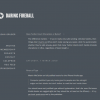You may think that your website is merely one extension of your business, but in today’s day and age, it plays a vital role for your overall brand. If you aren’t prioritizing website design and user experience, then you’re messing up big time.
Five Ways Poor Web Design Costs You
For ecommerce websites, few things matter more than UX. Customers want to be satisfied and will quickly leave if you don’t give them what they’re looking for.
“In the current omni-channel retail environment, online storefronts are no longer simply a brand’s digital checkout,” says Tracey Wallace of BigCommerce, an ecommerce platform for growing businesses. “They must be also shopping destinations providing unique online experiences unparalleled by competitors or the industry at large. Your ecommerce website is a form of media – owned media – and you must begin thinking of it in this way.”
But have you ever paused to think about the specific costs and negative effects of poor website design and lackluster UX?
1. Designer Costs
The number one reason people choose to go with budget websites and cheap layouts is they want to save money. Unfortunately, all they’re doing is saving money upfront. What most soon realize is that the website they paid for isn’t very effective or high converting. This forces them to invest in a new website, hire a professional designer, or spend money on frequent updates. As a result, they end up spending more than they would have if they had just paid a quality designer in the beginning.
2. Shopping Cart Abandonment
Shopping cart abandonment is a very real thing. The average ecommerce site has a rate right around 68.81 percent. But if you have rates in the 70s or 80s, something is wrong. It means you’re driving away an abnormally high percentage of sales. Most likely, this is an indication that some aspect of your website’s design or UX is flawed.
3. Poor SEO
Believe it or not, low-quality website design can lead to poor SEO. Without the appropriate navigation structure, keyword inclusion, image formatting, and page structure, you won’t be ranked very highly. This damages the long-term growth potential of your website and can have some seriously detrimental effects on sales.
4. Lost Productivity
“In 2013, the 100 year old Avon Products company pulled the plug on a $125 million mobile software overhaul after a pilot of the system in Canada revealed that the iPad rollout was too difficult to use and many sales reps began to quit the company,” designer Henry Swasey explains.
This is just one example of how important website design and UX really are. If you and your team can’t use the site efficiently, then productivity will wane and frustrations will mount.
5. Diminished Brand Reputation
Ultimately, bad website design will leave you with a diminished brand reputation. While this is the most detrimental effect, it’s the last one you’ll notice. Thus, your poor site design and UX could end up costing you your business if you don’t correct the mistakes in a timely fashion.
6. How Will You Respond?
Chances are, you know if your website is poorly designed. You’ve felt the repercussions of expensive web design revisions, shopping cart abandonment, poor SEO, lost productivity, and diminished brand reputation. But what can you do?
Well, for starters, you need to align your brand with the right web hosting platform and design team. It may cost a little bit more, but the correct infrastructure and partners will allow you to dig your way out and thrive.
